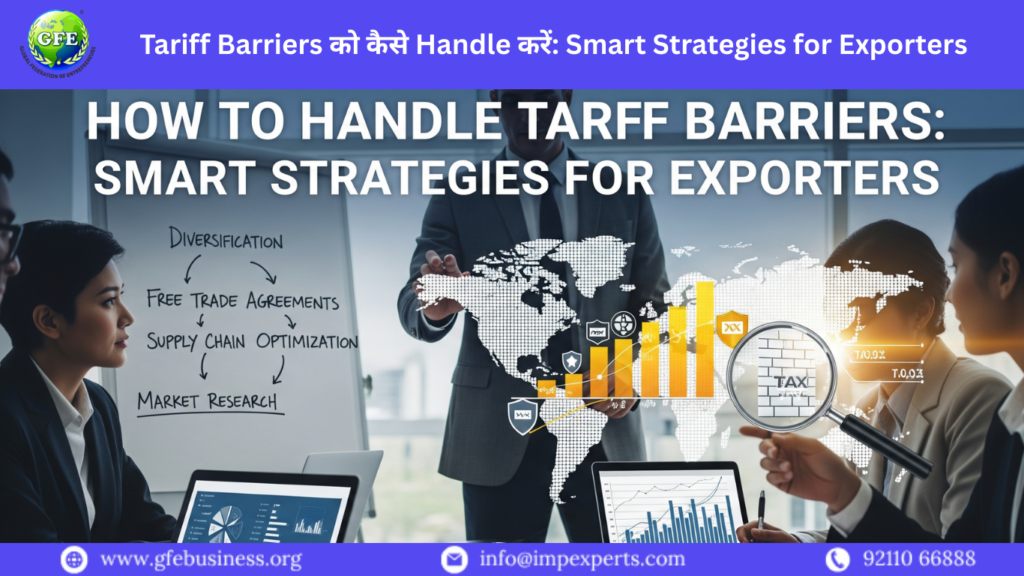For Indian exporters, tariff barriers are one of the toughest hurdles in international trade. A 5–20% tariff difference can completely alter product competitiveness, and sudden tariff hikes (जैसे Trump Tariffs 2025) can wipe out profits overnight.
Tariffs are not just government charges—they’re strategic tools countries use to protect their industries. That means exporters must treat tariffs not as “fixed costs,” but as challenges to be managed, optimized, and sometimes avoided legally through smart planning.
At GFE Business, exporters learn step-by-step frameworks to identify tariff risks, apply Free Trade Agreement (FTA) benefits, and re-engineer pricing strategies. In this guide, we’ll cover:
What tariff barriers are and why they matter
Types of tariffs exporters face
Real-world examples of tariff shocks
Smart strategies to handle tariff barriers
How to use FTAs, HS codes, and COOs effectively
Checklists to reduce landed costs
Success stories of Indian exporters who turned tariff risks into opportunities
By the end, you’ll know exactly how to tackle tariff barriers like a pro and protect your margins in global trade.
What are Tariff Barriers?
A tariff barrier is a tax or duty imposed on imported goods, making them more expensive in the destination country. Governments use tariffs to:
Protect domestic industries
Raise revenue
Counter foreign competition
Influence trade balances
For exporters, tariffs are a double-edged sword:
If your country faces high tariffs, your goods become costlier, and buyers may switch to competitors.
But if another country (like China) faces tariff hikes, your products can suddenly gain an advantage.
Types of Tariff Barriers Exporters Face
Ad Valorem Tariff
Percentage of product value (e.g., 10% of CIF value).
Example: 12% tariff on Indian garments in the EU.
Specific Tariff
Fixed per unit/weight (e.g., $2/kg).
Example: $1.5/kg duty on seafood in Japan.
Compound Tariff
Combination of ad valorem + specific.
Seasonal Tariffs
Applied during certain times (e.g., agriculture products).
Anti-Dumping / Countervailing Duties
To counter unfair subsidies or below-market pricing.
Exporters must track which type applies to their HS Code.
Why Tariff Barriers Hurt Exporters
Price Competitiveness Lost → Your $100 product becomes $115 after tariffs.
Margins Shrink → Importers pass tariff costs back to exporters through negotiation.
Market Access Reduced → Some countries become unviable due to high tariffs.
Cash Flow Strain → Import duties are payable at port before clearance.
Real-World Examples
U.S. Tariffs on Shrimp
Anti-dumping duties on Indian shrimp raised landed costs, forcing exporters to renegotiate contracts.
EU Tariffs on Rice
Basmati rice exporters saw tariffs rise when GSP+ benefits lapsed temporarily.
Trump Tariffs 2025
Textiles and gems from certain countries now face 50% tariffs in the U.S. → Indian exporters may benefit if they position correctly.
Lesson: Tariffs change with politics, trade wars, and agreements.
Smart Strategies to Handle Tariff Barriers
1. Leverage Free Trade Agreements (FTAs)
India has signed FTAs with Japan, UAE, ASEAN, Australia, etc.
Example: Shrimp exports to Japan → 0% duty under India–Japan CEPA.
Strategy: Always check FTA tariff schedules before finalizing a quote.
2. Use Certificates of Origin (COO) Correctly
A valid COO can reduce tariffs to zero in many markets.
Mistake: Many exporters forget or incorrectly file COO, losing benefits.
3. Choose Tariff-Friendly Markets
If U.S. tariffs are high, consider UAE, EU, or ASEAN markets with lower duties.
Example: Indian jewellery exports → 0% duty in UAE post-CEPA.
4. Product Reclassification via HS Codes
Some products qualify under multiple HS Codes.
Correct classification can reduce tariffs significantly.
Always seek an Advance Ruling to avoid disputes.
5. Value Addition & Processing
Adding processing steps in India can change HS Code → lower tariff.
Example: Instead of exporting raw cotton, export finished garments (higher value, better margins).
6. Negotiate with Buyers Using Incoterms
Smart use of FOB, CIF, DDP shifts tariff risk strategically.
Example: Quoting FOB lets buyer handle tariffs.
7. Use Duty Drawback & Refund Schemes
India’s RoDTEP & Duty Drawback refund schemes help offset tariff disadvantages.
8. Partner with Local Import Agents
Agents in the destination country often know exemptions and tariff loopholes.
Checklist: How Exporters Should Respond to Tariff Barriers
Identify HS Code accurately
Check WTO + destination customs tariff database
Verify if FTA benefits apply
Obtain Certificate of Origin (COO)
Calculate landed cost with duties
Add tariff buffers in quotations
Explore duty drawback/refund schemes
Keep backup markets ready
Case Studies: Indian Exporters Winning Despite Tariffs
Case 1: Tirupur Garment Exporter
Faced 12% EU tariffs.
Shifted to UAE market under CEPA → 0% tariff.
Sales grew 18% in one year.
Case 2: Andhra Shrimp Exporter
Anti-dumping duties in U.S. hurt margins.
Shifted to Japan under CEPA (0% duty).
Higher volumes offset lost U.S. business.
Case 3: Surat Diamond Exporter
Rising U.S. tariffs threatened jewellery margins.
Used COO under India–UAE CEPA → 0% duty.
Expanded UAE buyer base by 40%.
Opportunities Hidden in Tariff Barriers
Competitor Tariffs = Your Advantage → If China faces 25% tariffs, India gains.
FTA Markets = Open Doors → Japan, UAE, Australia are major growth hubs.
Product Shifts = Higher Margins → Move from raw exports to finished goods.
How GFE Business Helps Exporters
At GFE Business, exporters learn:
How to classify HS Codes correctly
How to check tariff rates in any country
How to claim FTA & GSP benefits
How to calculate landed cost with tariffs & duties
How to design tariff-smart pricing models
GFE Business provides training, consulting, and documentation support so SMEs don’t lose profits to tariff mistakes.
Conclusion
Tariff barriers are not going away—they are becoming sharper with global trade wars and protectionist policies. But smart exporters don’t fear tariffs—they plan around them.
By using HS codes, FTAs, COOs, and market diversification, Indian exporters can reduce costs, protect margins, and even turn tariffs into competitive advantages.
If you want step-by-step guidance on handling tariff barriers and expanding globally, connect with GFE Business.
Tariff barriers can shrink your profits—or fuel your growth. The difference lies in your strategy.








